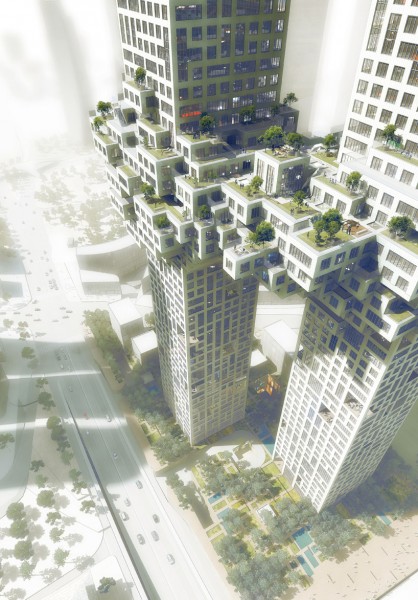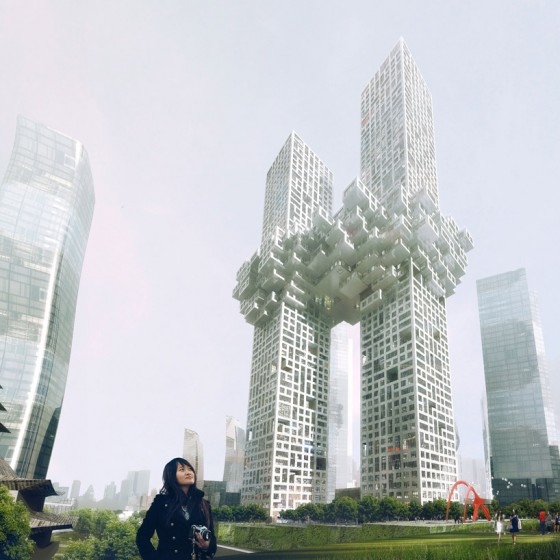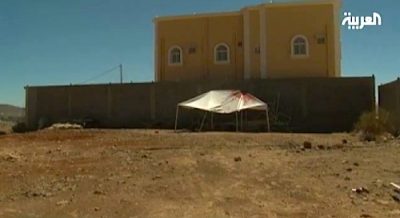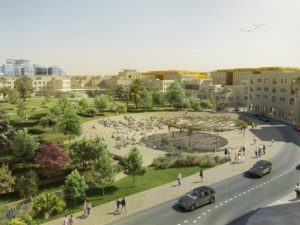Rotterdam-based architects MVRDV were smacked with a powerful backlash after unveiling their design for The Cloud, a pair of posh residential skyscrapers located in Seoul, Korea. Hovering about 300 meters above the streetscape, the towers are linked at the 27th floor by a ten-story-high girdle of cubist forms, intended to represent a pixelated “cloud“. The building is sited at the entrance of a new business district, the Yongsan Dreamhub, designed by wunderkind Daniel Libeskind.
The concept’s not awful and something tower builders in the Middle East can learn from: raise up private green spaces typically placed at ground level to the sky. Create more surface for greenery, increase interior daylighting, and use street level set-backs for an open-to-public park. Occupants will hop express elevators that shoot them into this lofty “bridge” connecting both towers. The 14,000 m2 volume will house a sky lounge, restaurants, a conference center, and health club. Vegetated roofs, open decks and swimming pools will sit atop the stacked cubes, centrally located to all residents, offering astounding (and vertigo-inducing) city views.
 Cross-ventilation and daylighting are important aspects of the apartments’ design, and material selection is purportedly eco-sensitive. Hardly a net-zero undertaking, but that’s not its biggest gaff. Construction is expected to be completed by 2015, likely beating reconstruction of its archetypical forerunner, New York’s World Trade Center.
Cross-ventilation and daylighting are important aspects of the apartments’ design, and material selection is purportedly eco-sensitive. Hardly a net-zero undertaking, but that’s not its biggest gaff. Construction is expected to be completed by 2015, likely beating reconstruction of its archetypical forerunner, New York’s World Trade Center.
Most architecture school newbies snooze through a 101 course in metaphoric and anthropomorphic design. This stuff is (literally) ancient history.
In symbolic – or metaphoric – architecture, the designer uses the building’s appearance to create an association between two dissimilar entities, purposely evoking specific feelings or moods. Throughout time, places of worship were built in forms meant to conjur mysticism and devotion. Iconic cultural facilities frequently play on this technique. The Sydney Opera House mirrors sailboats in the nearby bay.
Libeskind shaped his expansion of Berlin’s Jewish Museum as a deconstructed Star of David. Even transportation hubs work with symbols: Hajj Terminal drew on Bedouin tents.
Sometimes building imagery relates to the human body, a technique described as anthropomorphic design.
Minuro Takeyama’s Hotel Beverly caused shockwaves forty years ago with its phallic massing. The abominable entrance to Auschwitz is eternally haunting: beady eyes above a gaping mouth. Subtlety is critical to the success of these design strategies: the references shouldn’t be immediately obvious.
MVRDV has a masterful portfolio of past work; contextually sensitivity, intelligently rendered, incorporating leading edge environmental elements and even designing a few metaphors of their own. But they tripped up on this one. And, as for subtlety?
In 2001, a visual of the world’s most famous building collapse was tattooed onto our collective memory. The Cloud’s similarity to Manhattan’s World Trade Center under attack has touched a global nerve; criticism has been streaming in from designers, the public, and anti-terror groups. MVRDV has issued an apology, stating that the likeness wasn’t intentional.
Intentionality aside, The Cloud is not so much a metaphor of 9/11 as it is a permament recreation in steel and concrete and glass. Could this be the birth of a new branch of design? The Disney-fication of great moments in architectural horror?
It’s only subtlety is in its subliminal pitch to optometrists everywhere: some architects in Rotterdam need their eyes checked.
Images via MVRDV




Beautifully said, Jim.
I swing between thinking this is unintended similarity – versus – a clumsy grab for press (which I serve by writing about it).
Would public reaction be stronger if this building was sited in downtown Manhattan, or Riyadh?
Thanks for your comment.
I support designing in defiance of terror. Design how you please and let your creativity guide you freely. This design, however, just made my heart sink. It seems almost intentionally evocative of the WTC attack, with the intitial fire ball as the 767s hit the towers.I have tried to get over the extreme sadness every time I think about it and now know I never will see or think about the WTC site without my heart sinking. I do not need another site from which to avert my eyes. I now know how we took it for granted working in the WTC; there were so many people, and such a beehive of a community and it all seemed so routine until it wasn’t.